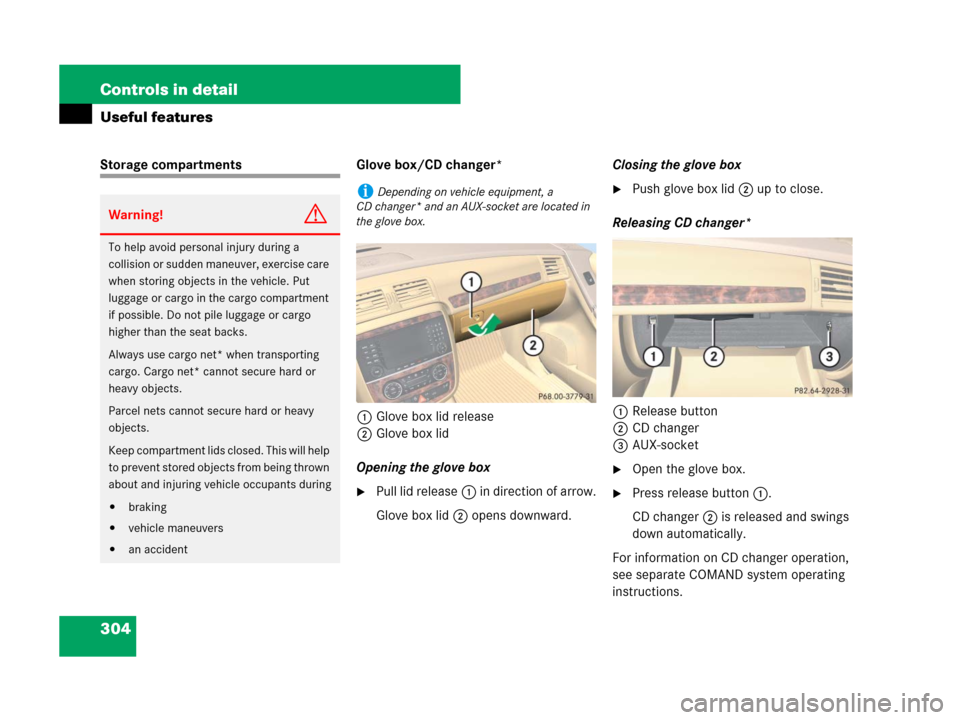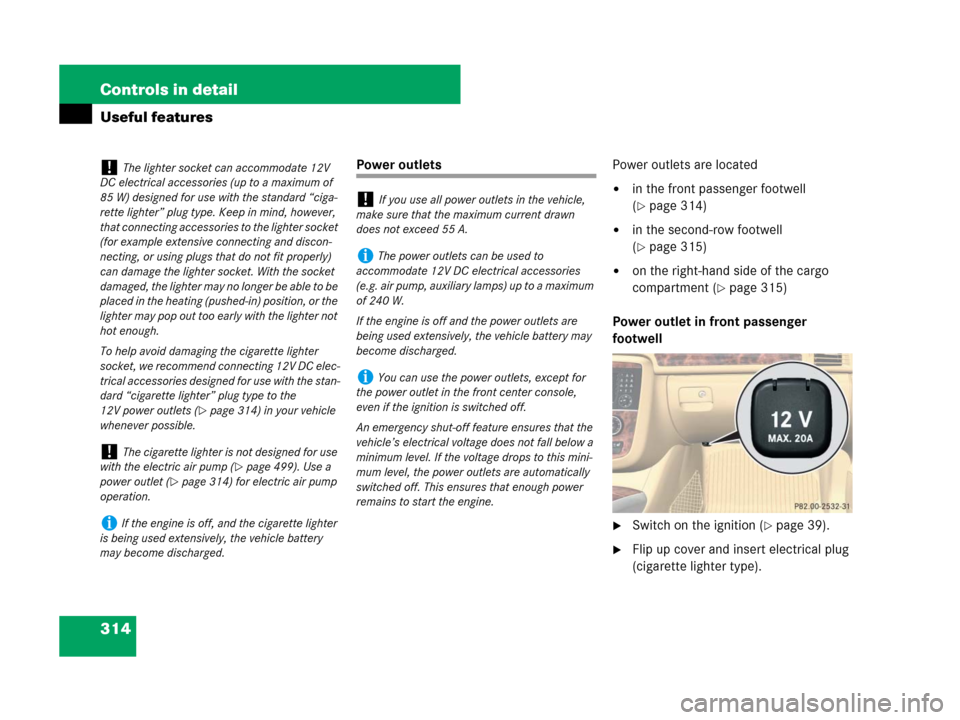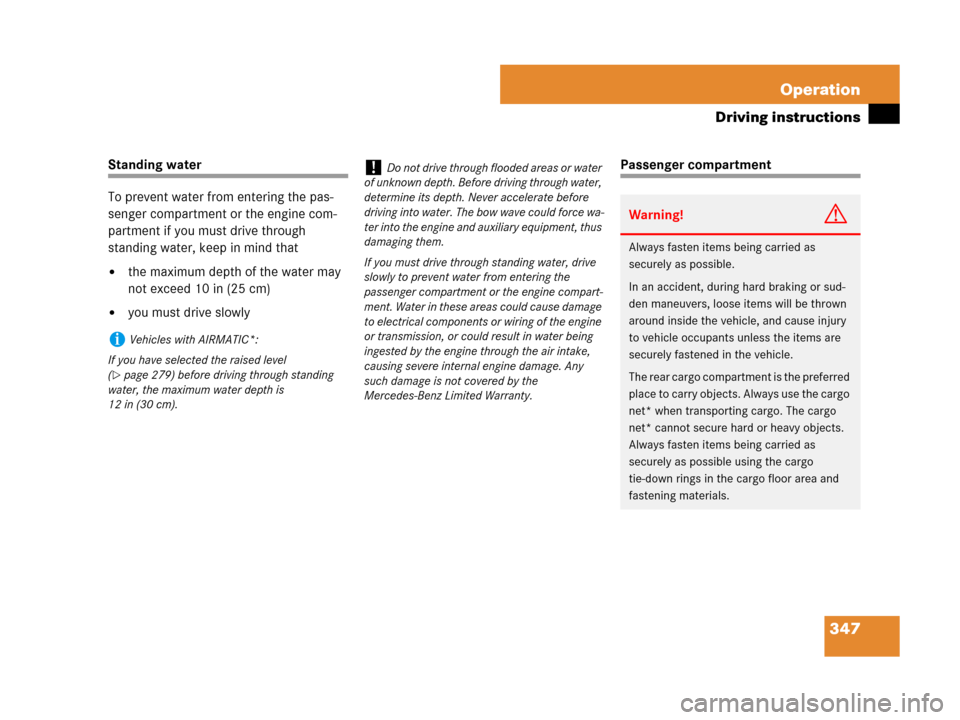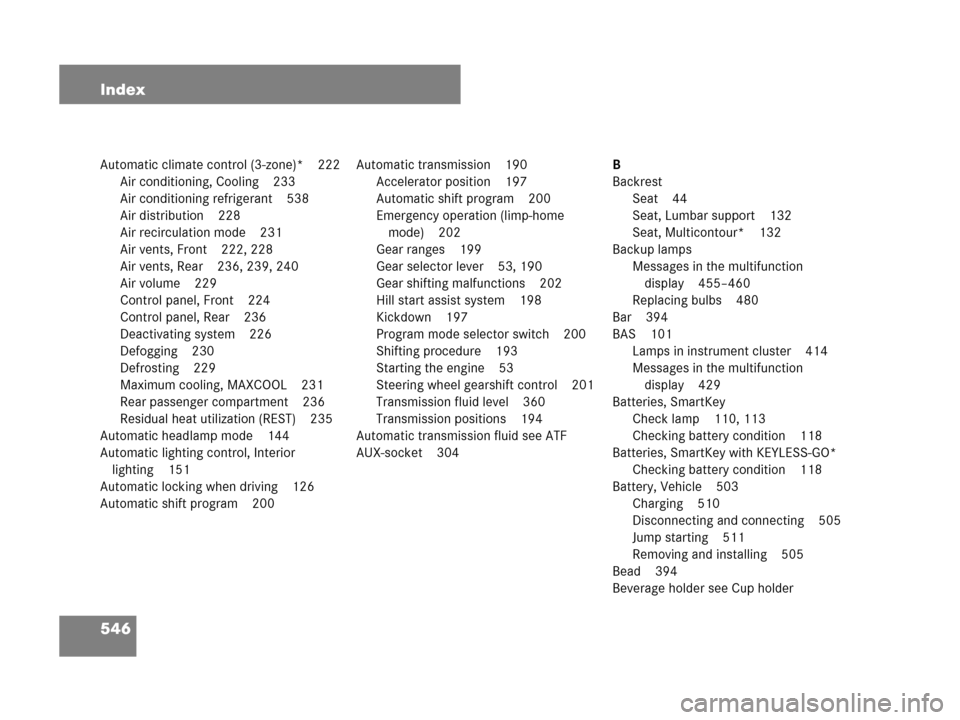Page 26 of 569
25 At a glance
Cockpit
ItemPage
1Cruise control lever258
2Instrument cluster26
3Multifunction steering
wheel30
4Horn
5Steering wheel gearshift
buttons201
6Gear selector lever for
automatic transmission53
7Front Parktronic* warning
indicators283
8Overhead control panel33
9Glove box release
Glove box lock304
305
ItemPage
aGlove box
CD changer*
AUX-socket304
304
304
bCenter console31
cPower outlet314
dStarter switch39
eSteering wheel adjustment,
manual46
fSteering wheel adjustment,
electrical*47
Heated steering wheel*318
gHood lock release356
hParking brake release56
ItemPage
jParking brake pedal65
kDoor control panel36
lExterior lamp switch143
mCombination switch
�High beam58
�Turn signals59
�Windshield wipers59
�Rear window wiper61
Page 305 of 569

304 Controls in detail
Useful features
Storage compartments Glove box/CD changer*
1Glove box lid release
2Glove box lid
Opening the glove box
�Pull lid release1 in direction of arrow.
Glove box lid2 opens downward.Closing the glove box
�Push glove box lid 2 up to close.
Releasing CD changer*
1Release button
2CD changer
3AUX-socket
�Open the glove box.
�Press release button 1.
CD changer 2 is released and swings
down automatically.
For information on CD changer operation,
see separate COMAND system operating
instructions.
Warning!G
To help avoid personal injury during a
collision or sudden maneuver, exercise care
when storing objects in the vehicle. Put
luggage or cargo in the cargo compartment
if possible. Do not pile luggage or cargo
higher than the seat backs.
Always use cargo net* when transporting
cargo. Cargo net* cannot secure hard or
heavy objects.
Parcel nets cannot secure hard or heavy
objects.
Keep compartment lids closed. This will help
to prevent stored objects from being thrown
about and injuring vehicle occupants during
�braking
�vehicle maneuvers
�an accident
iDepending on vehicle equipment, a
CD changer* and an AUX-socket are located in
the glove box.
Page 315 of 569

314 Controls in detail
Useful features
Power outletsPower outlets are located
�in the front passenger footwell
(
�page 314)
�in the second-row footwell
(
�page 315)
�on the right-hand side of the cargo
compartment (
�page 315)
Power outlet in front passenger
footwell
�Switch on the ignition (�page 39).
�Flip up cover and insert electrical plug
(cigarette lighter type).
!The lighter socket can accommodate 12V
DC electrical accessories (up to a maximum of
85 W) designed for use with the standard “ciga-
rette lighter” plug type. Keep in mind, however,
that connecting accessories to the lighter socket
(for example extensive connecting and discon-
necting, or using plugs that do not fit properly)
can damage the lighter socket. With the socket
damaged, the lighter may no longer be able to be
placed in the heating (pushed-in) position, or the
lighter may pop out too early with the lighter not
hot enough.
To help avoid damaging the cigarette lighter
socket, we recommend connecting 12V DC elec-
trical accessories designed for use with the stan-
dard “cigarette lighter” plug type to the
12V power outlets (
�page 314) in your vehicle
whenever possible.
!The cigarette lighter is not designed for use
with the electric air pump (
�page 499). Use a
power outlet (
�page 314) for electric air pump
operation.
iIf the engine is off, and the cigarette lighter
is being used extensively, the vehicle battery
may become discharged.
!If you use all power outlets in the vehicle,
make sure that the maximum current drawn
does not exceed 55 A.
iThe power outlets can be used to
accommodate 12V DC electrical accessories
(e.g. air pump, auxiliary lamps) up to a maximum
of 240 W.
If the engine is off and the power outlets are
being used extensively, the vehicle battery may
become discharged.
iYou can use the power outlets, except for
the power outlet in the front center console,
even if the ignition is switched off.
An emergency shut-off feature ensures that the
vehicle’s electrical voltage does not fall below a
minimum level. If the voltage drops to this mini-
mum level, the power outlets are automatically
switched off. This ensures that enough power
remains to start the engine.
Page 348 of 569

347 Operation
Driving instructions
Standing water
To prevent water from entering the pas-
senger compartment or the engine com-
partment if you must drive through
standing water, keep in mind that
�the maximum depth of the water may
not exceed 10 in (25 cm)
�you must drive slowly
Passenger compartment
iVehicles with AIRMATIC*:
If you have selected the raised level
(
�page 279) before driving through standing
water, the maximum water depth is
12 in (30 cm).
!Do not drive through flooded areas or water
of unknown depth. Before driving through water,
determine its depth. Never accelerate before
driving into water. The bow wave could force wa-
ter into the engine and auxiliary equipment, thus
damaging them.
If you must drive through standing water, drive
slowly to prevent water from entering the
passenger compartment or the engine compart-
ment. Water in these areas could cause damage
to electrical components or wiring of the engine
or transmission, or could result in water being
ingested by the engine through the air intake,
causing severe internal engine damage. Any
such damage is not covered by the
Mercedes-Benz Limited Warranty.
Warning!G
Always fasten items being carried as
securely as possible.
In an accident, during hard braking or sud-
den maneuvers, loose items will be thrown
around inside the vehicle, and cause injury
to vehicle occupants unless the items are
securely fastened in the vehicle.
The rear cargo compartment is the preferred
place to carry objects. Always use the cargo
net* when transporting cargo. The cargo
net* cannot secure hard or heavy objects.
Always fasten items being carried as
securely as possible using the cargo
tie-down rings in the cargo floor area and
fastening materials.
Page 547 of 569

546 Index
Automatic climate control (3-zone)* 222
Air conditioning, Cooling 233
Air conditioning refrigerant 538
Air distribution 228
Air recirculation mode 231
Air vents, Front 222, 228
Air vents, Rear 236, 239, 240
Air volume 229
Control panel, Front 224
Control panel, Rear 236
Deactivating system 226
Defogging 230
Defrosting 229
Maximum cooling, MAXCOOL 231
Rear passenger compartment 236
Residual heat utilization (REST) 235
Automatic headlamp mode 144
Automatic lighting control, Interior
lighting 151
Automatic locking when driving 126
Automatic shift program 200Automatic transmission 190
Accelerator position 197
Automatic shift program 200
Emergency operation (limp-home
mode) 202
Gear ranges 199
Gear selector lever 53, 190
Gear shifting malfunctions 202
Hill start assist system 198
Kickdown 197
Program mode selector switch 200
Shifting procedure 193
Starting the engine 53
Steering wheel gearshift control 201
Transmission fluid level 360
Transmission positions 194
Automatic transmission fluid see ATF
AUX-socket 304B
Backrest
Seat 44
Seat, Lumbar support 132
Seat, Multicontour* 132
Backup lamps
Messages in the multifunction
display 455–460
Replacing bulbs 480
Bar 394
BAS 101
Lamps in instrument cluster 414
Messages in the multifunction
display 429
Batteries, SmartKey
Check lamp 110, 113
Checking battery condition 118
Batteries, SmartKey with KEYLESS-GO*
Checking battery condition 118
Battery, Vehicle 503
Charging 510
Disconnecting and connecting 505
Jump starting 511
Removing and installing 505
Bead 394
Beverage holder see Cup holder